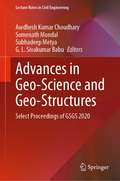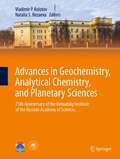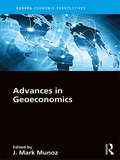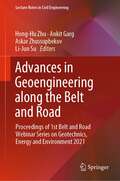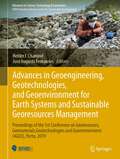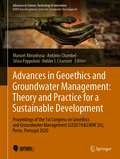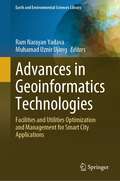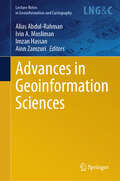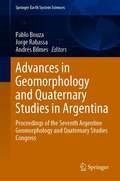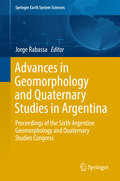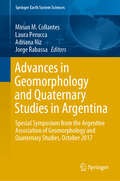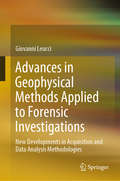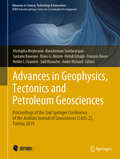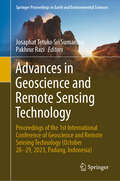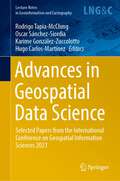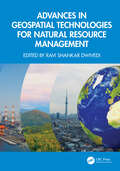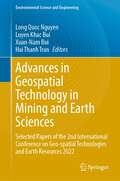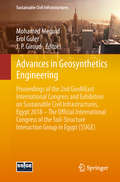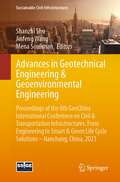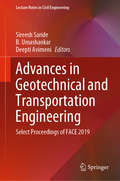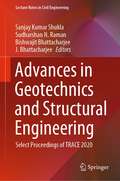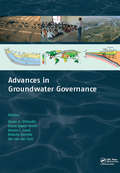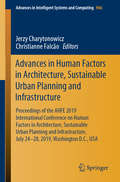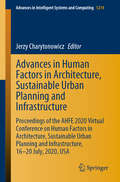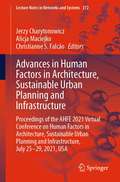- Table View
- List View
Advances in Geo-Science and Geo-Structures: Select Proceedings of GSGS 2020 (Lecture Notes in Civil Engineering #154)
by G. L. Sivakumar Babu Subhadeep Metya Awdhesh Kumar Choudhary Somenath MondalThis book presents select proceedings of the National conference on Geo-Science and Geo-Structures (GSGS 2020). It provides sustainable solutions to various challenges encountered in the field of geotechnical engineering. The topics presented include advanced characterization to study the behavior of geomaterials, shallow and deep foundations including tunneling, use of geosynthetics and other soil reinforcing materials in minimizing slope failures and landslides, dynamics of soils and foundations, and its connection with energy geotechnics, transportation geotechnics, and offshore geotechnics. The book further highlights various aspects of ground improvement techniques by incorporating the use of industrial by-products, forensic analyses of geo-structures, instrumentation and sensing techniques in geotechnical engineering and issues associated with geo-environmental engineering. The book will be a valuable reference for budding researchers, academicians, practitioners and policymakers interested in sustainable practices associated with geotechnical engineering and related domains.
Advances in Geochemistry, Analytical Chemistry, and Planetary Sciences: 75th Anniversary of the Vernadsky Institute of the Russian Academy of Sciences
by Vladimir P. Kolotov Natalia S. BezaevaThis book presents 41 selected articles written by leading researchers from the Vernadsky Institute of Geochemistry and Analytical Chemistry, part of the Russian Academy of Sciences. The articles are grouped by the following topics: (1) Geochemistry, (2) Meteoritics, Cosmochemistry, Lunar and Planetary Sciences, (3) Biogeochemistry and Ecology, and (4) Analytical Chemistry, Radiochemistry, and Radioecology. The articles present recent experimental data, theoretical investigations, critical reviews, the results of computer modeling in the above-mentioned fields.Intended to provide a scientific “snapshot” of the institute, the book also includes content on its history, main scientific achievements and current goals, together with detailed descriptions of its 25 laboratories and three museums so as to promote new international collaborations.Given its scope, the book will be of interest to all scientists and graduate students working in the areas of geochemistry, analytical chemistry and radiochemistry, earth and environmental sciences, biogeosciences, meteoritics and planetary science, and to those seeking new collaboration opportunities in these areas in Russia.
Advances in Geoeconomics (Europa Economic Perspectives)
by J Mark MunozWhile geopolitics has captured global attention, geoeconomics is the often hidden force that governs countries’ relationships. It is the economic psyche that shapes the new world order. Geoeconomics refers to the intersection of economic factors, relationships and conditions on global events. A country’s political and business alignments have an impact on individuals, companies and on future economic stability. This book assembles leading scholars and experts from around the world to advance current thinking on geoeconomics. It is a thorough and authoritative reference work on world economics that aims to shape strategy formulation in business and government for years to come by expanding understanding on the topic of geoeconomics, analyzing the implications of international geoeconomic events, and providing the reader with theoretical and practical approaches on the management of geoeconomics. Geoeconomic concepts in this book will prove timely and highly insightful to students, academics, executives, entrepreneurs, government officials, consultants and policymakers.
Advances in Geoengineering along the Belt and Road: Proceedings of 1st Belt and Road Webinar Series on Geotechnics, Energy and Environment 2021 (Lecture Notes in Civil Engineering #230)
by Ankit Garg Askar Zhussupbekov Hong-Hu Zhu Li-Jun SuThis book is a compilation of selected papers from the 1st Belt and Road Webinar Series on Geotechnics, Energy and Environment, March - May 2021. The book comprises selected research related to advances in geo-environmental engineering. Topics covered include rock mechanics, sustainable materials, frozen soils, geotechnical innovations in megacities. The research is related to the sustainable infrastructure development for countries in China's Belt and Road Initiative. The contents of the volume will prove useful to researchers and professionals working in geotechnical and geological engineering domains.
Advances in Geoengineering, Geotechnologies, and Geoenvironment for Earth Systems and Sustainable Georesources Management: Proceedings of the 1st Conference on Georesources, Geomaterials, Geotechnologies and Geoenvironment (4GEO), Porto, 2019 (Advances in Science, Technology & Innovation)
by Helder I. Chaminé José Augusto FernandesThis book comprises the peer-reviewed proceedings of the 1st Conference on Georesources, Geomaterials, Geotechnologies and Geoenvironment (4GEO), Porto, Portugal, on November 7–8, 2019. The book interests all researchers, practitioners, and students in engineering geosciences, geotechnics, georesources, materials engineering, and earth and environmental sciences.Georesources, geomaterials, geotechnologies, and geoenvironment are very topical subjects and therefore deserve a deeper reflection by academia, practitioners, and society. That approach is vital to a correct sustainable resource management and an engineering design with nature within a geoethical framework. Georesources, understood as geological, hydrological and energetic resources are greatly important to society. Minerals, rocks, and water are resources that, over time, have assumed an important role in the technological development of communities. Given the increase in population and the increasing needs and intensification of their use, it is very important to ensure their sustainable management. Geomaterials are functional geological materials artificially processed for the generality of the activities developed by societies. The functional geomaterials may include rock, clay, granular materials, treated soils, and industrial waste. Geotechnologies are a very important tool for decision-making, supporting the collection, mapping, processing, and analysis of data with geographical information systems and other geo-techniques used in the most diverse fields, including to support the monitoring and prediction of geohazards. The geoenvironment is a transversal field that identifies continuous earth changes and to find solutions to the resulting socioeconomic and environmental changes. Climate change, industrialization, and anthropic activity are, among others, factors of pressure and alteration of the natural environment, so minimizing impacts and emerging hazards and risks.Main topics include:1. Geomaterials, Geotechnics, and Georesources2. Geotechnologies, Engineering Geosciences, and Geohazards3. Geoenvironment, Water, and Climate Change
Advances in Geoethics and Groundwater Management: Proceedings of the 1st Congress on Geoethics and Groundwater Management (GEOETH&GWM'20), Porto, Portugal 2020 (Advances in Science, Technology & Innovation)
by Silvia Peppoloni Helder I. Chaminé Manuel Abrunhosa António ChambelThis book gathers the peer-reviewed proceedings of the 1st congress on Geoethics & Groundwater Management (GEOETH&GWM'20), held in Porto, Portugal, in an online format on 18-22 May 2020. Hosted in School of Engineering (ISEP), Polytechnic of Porto based on Porto city (a UNESCO World Heritage Site), the international conference focused on what has now been dubbed “hydrogeoethics”, a novel transdisciplinary, scientific field integrating all dimensions of geoethics in groundwater science and practice. Given its scope, the book is of interest to all researchers and practitioners in the geosciences, hydrology, water resources, hydrogeology, natural resources management, environment, engineering, law, sociology, education, philosophy, culture, among others.This joint congress is the result of a collaborative agreement between the IAH (International Association of Hydrogeologists) and IAPG (International Association for Promoting Geoethics) and reflects the need for concerted actions to achieve sustainable development.The diversity, scale, significance and increasing magnitude of anthropogenic interactions with aquifers and groundwater, which often involve conflicting values or interests, call for analysis, discussions and decisions on the part of the agents involved, e.g. groundwater scientists, policymakers, managers, organisations, professionals and citizens. This approach calls for a responsible, sustainable and human approach to groundwater use and management.The groundwater community involved in the exploration and exploitation, use and management of this increasingly vital natural resource is becoming more and more aware that ethical issues pervade all our attitudes from concept to action and need to be addressed. Diverse values and cultures, science and education, law and policies, human and natural environments and the public and the economic sectors view groundwater and its value and/or role differently. The authors believe that in a globalised and interconnected world, common ground must be found in the interest of peace, human development and sustainability. The main topics covered here include:1. Fundamentals of hydrogeoethics: cultures, principles and geoethical values on groundwater science and engineering2. Lessons for a resilient and sustainable future with hydrogeoethics: case studies of geoethics in groundwater science-engineering, profession, and management3. Scientific and humanistic components of hydrogeoethics in groundwater education and professional training 4. Socio-hydrogeology and ethical groundwater management 5. Geoethics of decision making under uncertainty and ethical issues in neglecting groundwater functioning 6. Groundwater: geological, legal, social, and ethical challenges of a unique natural resource
Advances in Geoinformatics Technologies: Facilities and Utilities Optimization and Management for Smart City Applications (Earth and Environmental Sciences Library)
by Ram Narayan Yadava Muhamad Uznir UjangThere are many GIS products for smart cities to implement smart city projects or activities. Most of the Geoinformatics Technologies and its application books are theoretical and lack of examples with real world data and step by step explanations to understand the facilities and utilities optimization and management for smart city applications and socio-economic aspects.This book focuses and discusses topics related to how technological advances in Geoinformatics can help in the management operations of smart city applications to help our environment to be smart. Specifically, the volume focuses on how these advancements can help optimize and manage facilities and utilities. This book focuses on geoinformation modelling, geo-smart city applications, geoinformation technology, information system and computer science, and geolocation and positioning as its five primary areas of discussion. Each of these primary subjects delves into the application that uses geoinformatics technology in greater depth. This covers the use of Geoinformatics technology in the prevention of crime, coastal erosion, carbon emission modelling, landslide modelling, urban farming, and various other applications linked to the field. This book's objective is to provide a comprehensive review of the accomplishments that geoinformatics has made in a number of different application areas for smart cities. It covers Geoinformation Technologies, Geoinformation Modelling, Information System and Computer Science, Geolocation & Positioning, and Geo-Smart City Applications.The book will be useful to graduate students, university faculty, and researchers in Geoinformatics sciences/engineering and architecture and town planning. It will also be useful to entrepreneurs, professionals, and planners in policy and decision making at the local, state and national levels.
Advances in Geoinformation Sciences (Lecture Notes in Geoinformation and Cartography)
by Alias Abdul-Rahman Ivin A. Musliman Imzan Hassan Ainn ZamzuriProceedings of ESRI Users Conference series (by ESRI California); - This book provides discussions on the usage of the specific software like ArcGIS Pro, thus, unlike the intended book which is more advanced solutions and methods. Proceedings of 31st ACM International Conference (by ACM); - This book offers specific solutions to the computing and spatial science community but more for system developers etc, whereas this intended book has broader knowledge spectrum. Proceedings of 18th 3D Geoinfo International Conference (Springer). - This book specifically discusses on 3D GIS research, whereas the intended book gives more breadth thus offers extra insights to the knowledge.
Advances in Geomorphology and Quaternary Studies in Argentina: Proceedings of the Seventh Argentine Geomorphology and Quaternary Studies Congress (Springer Earth System Sciences)
by Jorge Rabassa Pablo Bouza Andrés BilmesThis book presents selected research highlights from the Seventh Argentine Geomorphology and Quaternary Studies Congress, hosted at Puerto Madryn, Northern Patagonia, Argentina by the Argentine Association of Geomorphology and Quaternary Studies (AACYG). The congress included special sessions, symposia, invited lectures and posters on the following topics: Quaternary stratigraphy and geochronology, paleontology (diatoms, mollusks, foraminifera, palynology, phytoliths, paleobotany, vertebrates), dendrochronology, climate change, paleoclimate, Pampean Quaternary paleolimnology, paleomagnetism, environmental magnetism, hydrogeochemical processes, geoarchaeology, geomorphology, structural geology and neotectonics, paleosurfaces, volcanism, geological hazards, assets, geomorphosites, and digital mapping. The Scientific Committee of the Congress has selected the papers published in this volume from more than 150 contributions in many different disciplines.
Advances in Geomorphology and Quaternary Studies in Argentina: Proceedings of the Sixth Argentine Geomorphology and Quaternary Studies Congress (Springer Earth System Sciences)
by Jorge RabassaThis proceedings volume presents selected research highlights from the Sixth Argentine Geomorphology and Quaternary Studies Congress, hosted at CADIC, Ushuaia, on April 8-12, 2015 by the Argentine Association of Geomorphology and Quaternary Studies (AACYG). The congress included special sessions, symposia, invited lectures and posters on the following topics: Quaternary stratigraphy and geochronology, paleontology (diatoms, mollusks, foraminifera, palynology, phytoliths, paleobotany, vertebrates), dendrochronology, climate change, paleoclimate, Pampean Quaternary paleolimnology, paleomagnetism, environmental magnetism, hydrogeochemical processes, geoarchaeology, geomorphology, structural geology and neotectonics, paleosurfaces, volcanism, geological hazards, assets, geomorphosites, and digital mapping. The Scientific Committee of the Congress has selected the papers published in this volume from more than 150 contributions in many different disciplines.
Advances in Geomorphology and Quaternary Studies in Argentina: Special Symposium from the Argentine Association of Geomorphology and Quaternary Studies, October 2017 (Springer Earth System Sciences)
by Jorge Rabassa Mirian M. Collantes Laura Perucca Adriana NizThese proceedings contain selected papers from the Special Symposium, organised by the Argentine Association of Geomorphology and Quaternary Studies in October 2017. This Symposium was held within the frame of the 20th Argentine Geological Congress in Tucumán, Argentina. The papers describe detailed research on quaternary stratigraphy and geochronology, paleontology (diatoms, mollusks, foraminifera, palynology, phytoliths, paleobotany, vertebrates), dendrochronology, climate change, paleoclimate, pampeano quaternary paleolimnology, paleomagnetism, environmental magnetism, hydrogeochemical processes, geoarchaeology, geomorphology, structural geology and neotectonics, paleosurfaces, volcanism, risks, assets, geomorphosites, and digital mapping.This book follows the precedent book “Advances in Geomorphology and Quaternary Studies in Argentina” on the 6th Argentine Geomorphology and Quaternary Studies Congress, which was edited by Jorge Rabassa and published by Springer in 2017. It precedes a similar volume on the 7th Congreso Argentino de Cuaternario y Geomorfología, “Geocuar 2018”, as organized by Argentine Association of Geomorphology and Quaternary Studies (AACG). This conference was held in Puerto Madryn, Chubut, Argentina, from 18 to 21 September 2018.
Advances in Geophysical Methods Applied to Forensic Investigations: New Developments in Acquisition and Data Analysis Methodologies
by Giovanni LeucciThis book provides a general introduction to the most important geophysical exploration methods and their application to forensic sciences. It describes physical principles, campaign procedures and processing, as well as interpretation techniques, while also highlighting new acquisition and data analysis procedures. A large section of the book is devoted to applications, from measurements to the interpretation of data. Further, the book shows how to design and perform a forensic survey, and offers guidance on selecting the best method for the problem at hand, and on selecting the best type of data acquisition and processing. Written in straightforward language and chiefly intended as an introductory text for students in several scientific fields, the book also offers a useful guide for specialists who want to expand their expertise in this fascinating discipline.
Advances in Geophysics, Tectonics and Petroleum Geosciences: Proceedings of the 2nd Springer Conference of the Arabian Journal of Geosciences (CAJG-2), Tunisia 2019 (Advances in Science, Technology & Innovation)
by François Roure Santanu Banerjee Narasimman Sundararajan Mehdi Eshagh Mustapha Meghraoui Helder I. Chaminé Klaus-G. Hinzen André Michard Said MaoucheThis edited book is based on the best papers accepted for presentation during the 2nd Springer Conference of the Arabian Journal of Geosciences (CAJG-2), Tunisia, in 2019. It is of interest to all researchers practicing geophysics/seismology, structural, and petroleum geology.With four sections spanning a large spectrum of geological and geophysical topics with particular reference to Middle East, Mediterranean region, and Africa, this book presents a series of research methods that are nowadays in use for measuring, quantifying, and analyzing several geological domains.It starts with a subsection dedicated to the latest research studies on seismic hazard and risk assessment in Africa presented during the 2019 IGCP-659 meeting organized alongside the CAJG-2. And, it includes new research studies on earthquake geodesy, seismotectonics, archeoseismology and active faulting, well logging methods, geodesy and exploration/theoretical geophysics, petroleum geochemistry, petroleum engineering, structural geology, basement architecture and potential data, tectonics and geodynamics, and thermicity, petroleum, and other georesources. The edited book gives insights into the fundamental questions that address the genesis and evolution of our planet, and this is based on data collection and experimental investigations under physical constitutive laws. These multidisciplinary approaches combined with the geodynamics of tectonic provinces and investigations of potential zones of natural resources (petroleum reservoirs) provide the basis for a more sustainability in the economic development.
Advances in Geoscience and Remote Sensing Technology: Proceedings of the 1st International Conference of Geoscience and Remote Sensing Technology (October 28-29, 2023, Padang, Indonesia) (Springer Proceedings in Earth and Environmental Sciences)
by Josaphat Tetuko Sri Sumantyo Pakhrur RaziThis book comprises works presented in the 1st International Conference of Geoscience, Remote Sensing, and Technology, which was held in Padang, Indonesia, in October 2023. It was hosted by the Center of Disaster Monitoring and Earth Observation, State University of Padang, Indonesia. Included are works related but not limited to geoscience, remote sensing, radar SAR, optic satellites, LiDAR, earthquakes, drones, geophysics, computer science, computer engineering, information technology, and mapping.
Advances in Geospatial Data Science: Selected Papers from the International Conference on Geospatial Information Sciences 2021 (Lecture Notes in Geoinformation and Cartography)
by Rodrigo Tapia-McClung Oscar Sánchez-Siordia Karime González-Zuccolotto Hugo Carlos-MartínezThis book presents a selection of manuscripts submitted to the 2nd International Conference on Geospatial Information Sciences 2021, a virtual conference held on November 3-5, 2021. These papers were selected by the Scientific Program Committee of the Conference after a rigorous peer-review process. They represent the vast scope of the interdisciplinary research areas that characterize the Geospatial Information Sciences that is done in the discipline. It especially represents a fabulous opportunity to showcase research carried out by young Mexican researchers and showcase it to the rest of the world and enhance the growth of the sciences in the country while, at the same time, enforces them to level up with other research at the international level.
Advances in Geospatial Technologies for Natural Resource Management
by Ravi Shankar DwivediTimely and reliable information on natural resources, regarding their potential and limitations, is a prerequisite for sustainable development. Geospatial technologies offer immense potential in providing such information in a timely and cost-effective manner. Using orbital sensors data in conjunction with airborne and proximal sensors data to generate information on soils and agricultural resources, forests, mineral resources, fossil fuel, wetlands, water resources, and marine resources, this book focuses on the advancements in technologies applicable to managing these resources. It addresses global issues like climate change and land degradation neutrality and introduces spatial data infrastructure (SDI) as a mechanism for sharing geospatial data. This book also provides an in-depth discussion on drones, crowdsourcing, cloud computing, Internet of Things, machine learning, and their applications.FEATURES Contains a comprehensive resource on the latest developments in geospatial technologies and their use in monitoring natural resources, productivity mapping, and modeling Explains the geo-computation methods and online algorithm developments Includes clear guidance on how best to use geospatial data for various applications Discusses case studies from a variety of fields and current trends in the management of natural resources Provides future scenarios concerning platforms, sensors, data analysis, and interpretation techniques This book is written for remote sensing and GIS professionals in environmental institutions and government who are involved in natural resource management projects. Senior undergraduate and graduate-level students in Earth sciences, geography, or environmental management can also use this text for supplementary reading.
Advances in Geospatial Technology in Mining and Earth Sciences: Selected Papers of the 2nd International Conference on Geo-spatial Technologies and Earth Resources 2022 (Environmental Science and Engineering)
by Xuan-Nam Bui Long Quoc Nguyen Luyen Khac Bui Ha Thanh TranThis book composes the proceedings of the international conference on Geo-Spatial Technologies and Earth Resources (GTER 2022) which was co-organized by Hanoi University of Mining and Geology and the International Society for Mine Surveying (ISM) held at Hanoi city on October 13–14, 2022.GTER 2022 is technically co-sponsored by Vietnam Mining Science and Technology Association (VMST), Vietnam Association of Geodesy, Cartography and Remote Sensing (VGCR), Vietnam National Coal-Mineral Industries Holding Corporation Limited (VINACOMIN), and the Dong Bac Corporation (NECO).GTER 2022 aims to bring together experts, researchers, engineers, and policymakers to discuss and exchange their knowledge and experiences in recent geospatial technologies, advances in mining and earth sciences.
Advances in Geosynthetics Engineering: Proceedings of the 2nd GeoMEast International Congress and Exhibition on Sustainable Civil Infrastructures, Egypt 2018 – The Official International Congress of the Soil-Structure Interaction Group in Egypt (SSIGE) (Sustainable Civil Infrastructures)
by Erol Guler Mohamed Meguid J. P. GiroudThis volume contains contributions on advances in geosynthetics engineering. Soil reinforcement is a very useful technique to construct several cost-effective soil structures in an environmentally friendly and sustainable manner. The most commonly used reinforcement materials are galvanised steel strips, geosynthetics in the form of woven geotextiles, geogrids and geocomposites, and fibres from natural and waste products. In recent years, there have been advances in the area of soil reinforcement, especially in the utilization of the technique in field projects. The researchers have also been working to understand the behaviour of reinforced soil considering the field challenges of reinforced soil structures. The volume is based on the best contributions to the 2nd GeoMEast International Congress and Exhibition on Sustainable Civil Infrastructures, Egypt 2018 – The official international congress of the Soil-Structure Interaction Group in Egypt (SSIGE).
Advances in Geotechnical Engineering & Geoenvironmental Engineering: Proceedings of the 6th GeoChina International Conference on Civil & Transportation Infrastructures: From Engineering to Smart & Green Life Cycle Solutions -- Nanchang, China, 2021 (Sustainable Civil Infrastructures)
by Jinfeng Wang Shanzhi Shu Mena SoulimanThis book includes a collection of researches that contains research data, discussions and conclusions focusing on several related geotechnical aspects of infrastructure. Topics include issues related to civil infrastructure such as temperature-induced lateral earth pressure on bridge abutment, subsidence of high speed rail and expressway, application of recycled rubber mats, railway ballast evaluation, hurricane protection floodwall, tunnel portal stability, deep excavation case study and properties of contaminated soils. Various types of research were used in the various studies, including field measurements, numerical analyses and laboratory measurements. This findings and results should lead to more resilient infrastructure design, maintenance and management, which will provide benefits to both civil engineering practitioners, researchers and students
Advances in Geotechnical and Transportation Engineering: Select Proceedings of FACE 2019 (Lecture Notes in Civil Engineering #71)
by Sireesh Saride B. Umashankar Deepti AvirneniThis book presents the selected peer-reviewed papers from the national conference Futuristic Approaches in Civil Engineering (FACE) 2019. This volume focuses on latest research and challenges in the field of geotechnical, transportation, environmental and water resources engineering. The first part focuses on alternative and sustainable pavement materials, maintenance and rehabilitation of roads, transportation planning, traffic engineering, hybrid vehicles, safety management, and intelligent transport systems. In the second part of the book, basic and advanced research in geotechnical engineering which can provide sustainable solutions to practical problems in foundations, retaining structures, soil dynamics, site characterization, slope stability, dams, rock engineering, environmental geotechnics, and geosynthetics are covered. The third part of the book includes current research in environment, and water resources engineering. The contents of this book will be useful for students, researchers as well as industry professionals.
Advances in Geotechnics and Structural Engineering: Select Proceedings of TRACE 2020 (Lecture Notes in Civil Engineering #143)
by Sanjay Kumar Shukla J. Bhattacharjee Sudharshan N. Raman Bishwajit BhattacharjeeThis book comprises select proceedings of the International Conference on Trends and Recent Advances in Civil Engineering (TRACE 2020). The book focuses on the latest research developments in structural engineering, structural health monitoring, rehabilitation and retrofitting of structures, geotechnical engineering, and earthquake-resistant structures. The contents also cover the latest innovations in building repair and maintenance, and sustainable materials for rehabilitation and retrofitting. The contents of this book are useful for students, researchers, and professionals working in structural engineering and allied areas.
Advances in Groundwater Governance
by Karen G. Villholth Alberto Garrido Elena Lopez-Gunn Kirstin Conti Jac Van Der GunThis book addresses groundwater governance, a subject internationally recognized as crucial and topical for enhancing and safeguarding the benefits of groundwater and groundwater-dependent ecosystems to humanity, while ensuring water and food security under global change. The multiple and complex dimensions of groundwater governance are captured in 28 chapters, written by a team of leading experts from different parts of the world and with a variety of relevant professional backgrounds. The book aims to describe the state-of-the-art and latest developments regarding each of the themes addressed, paying attention to the wide variation of conditions observed around the globe. The book consists of four parts. The first part sets the stage by defining groundwater governance, exploring its emergence and evolution, framing it through a socio-ecological lens and describing groundwater policy and planning approaches. The second part discusses selected key aspects of groundwater governance. The third part zooms in on the increasingly important linkages between groundwater and other resources or sectors, and between local groundwater systems and phenomena or actions at the international or even global level. The fourth part, finally, presents a number of interesting case studies that illustrate contemporary practice in groundwater governance. In one volume, this highly accessible text not only familiarizes water professionals, decision-makers and local stakeholders with groundwater governance, but also provides them with ideas and inspiration for improving groundwater governance in their own environment.
Advances in Human Factors in Architecture, Sustainable Urban Planning and Infrastructure: Proceedings of the AHFE 2019 International Conference on Human Factors in Architecture, Sustainable Urban Planning and Infrastructure, July 24-28, 2019, Washington D.C., USA (Advances in Intelligent Systems and Computing #966)
by Jerzy Charytonowicz Christianne FalcãoThis book discusses human factors research directed towards realizing and assessing sustainability in the built environment and architecture. It reports on advanced engineering methods for sustainable infrastructure design, architecture as well as on assessments of the efficient methods and the social, environmental, and economic impact of various designs and projects. The book covers a range of topics, including the use of recycled materials in architecture, ergonomics in buildings and public design, sustainable design for smart cities, design for the aging population, industrial design, human scale in architecture, and many more. Based on the AHFE 2019 International Conference on Human Factors in Architecture, Sustainable Urban Planning and Infrastructure, held on July 24-28, 2019, in Washington D.C., USA, it offers various perspectives on sustainability and ergonomics. As such, it is a valuable reference resource for designers, urban engineers, architects, infrastructure professionals, public infrastructure owners, policy makers, government engineers and planners, as well as operations managers and academics active in urban and infrastructure research.
Advances in Human Factors in Architecture, Sustainable Urban Planning and Infrastructure: Proceedings of the AHFE 2020 Virtual Conference on Human Factors in Architecture, Sustainable Urban Planning and Infrastructure, 16-20 July, 2020, USA (Advances in Intelligent Systems and Computing #1214)
by Jerzy CharytonowiczThis book presents human factors research focused on achieving and assessing sustainability in the built environment and architecture. It reports on advanced engineering methods for architecture and design, and on assessments of the social, environmental, and economic impacts of various designs and projects. The book covers a broad range of practical studies relating to ergonomic design and assessment of public and private places, urban ecological constructions, and urban planning for smart city. Further topics include green area planning, environmentally-responsive architecture, and conservation and adaptation of vernacular architectures in modern design. Based on the AHFE 2020 Virtual Conference on Human Factors in Architecture, Sustainable Urban Planning and Infrastructure, held on July 16–20, 2020, this book offers a wealth of perspectives on sustainability and ergonomics in architecture and urban planning. As such, it represents a timely source of inspiration for designers, architects, urban planners, as well as civil and environmental engineers, and other professionals, including policy-makers, seeking for developing sustainable buildings and infrastructure.
Advances in Human Factors in Architecture, Sustainable Urban Planning and Infrastructure: Proceedings of the AHFE 2021 Virtual Conference on Human Factors in Architecture, Sustainable Urban Planning and Infrastructure, July 25-29, 2021, USA (Lecture Notes in Networks and Systems #272)
by Jerzy Charytonowicz Christianne S. Falcão Alicja MaciejkoThis book presents human factors research focused on achieving and assessing sustainability in the built environment and architecture. It reports on advanced engineering methods for architecture and design, and on assessments of the social, environmental, and economic impacts of various designs and projects. The book covers a broad range of practical studies relating to ergonomic design and assessment of public and private places, urban ecological constructions, and urban planning for smart city. Further topics include green area planning, environmentally-responsive architecture, and conservation and adaptation of vernacular architectures in modern design. Based on the AHFE 2021 Conference on Human Factors in Architecture, Sustainable Urban Planning and Infrastructure, held virtually on 25–29 July, 2021, from USA, this book offers a wealth of perspectives on sustainability and ergonomics in architecture and urban planning. As such, it represents a timely source of inspiration for designers, architects, urban planners, as well as civil and environmental engineers, and other professionals, including policy-makers, involved in the development of sustainable buildings and infrastructure.
